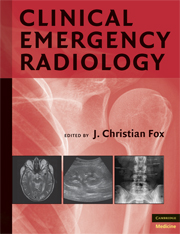Book contents
- Frontmatter
- Contents
- Contributors
- PART I PLAIN RADIOGRAPHY
- 1 Plain Radiography of the Upper Extremity in Adults
- 2 Lower Extremity Plain Radiography
- 3 Chest Radiograph
- 4 Plain Film Evaluation of the Abdomen
- 5 Plain Radiography of the Cervical Spine
- 6 Thoracolumbar Spine and Pelvis Plain Radiography
- 7 Plain Radiography of the Pediatric Extremity
- 8 Plain Radiographs of the Pediatric Chest
- 9 Plain Film Radiographs of the Pediatric Abdomen
- 10 Plain Radiography in Child Abuse
- 11 Plain Radiography in the Elderly
- PART II ULTRASOUND
- PART III COMPUTED TOMOGRAPHY
- PART IV MAGNETIC RESONANCE IMAGING
- Index
- Plate Section
11 - Plain Radiography in the Elderly
from PART I - PLAIN RADIOGRAPHY
Published online by Cambridge University Press: 07 December 2009
- Frontmatter
- Contents
- Contributors
- PART I PLAIN RADIOGRAPHY
- 1 Plain Radiography of the Upper Extremity in Adults
- 2 Lower Extremity Plain Radiography
- 3 Chest Radiograph
- 4 Plain Film Evaluation of the Abdomen
- 5 Plain Radiography of the Cervical Spine
- 6 Thoracolumbar Spine and Pelvis Plain Radiography
- 7 Plain Radiography of the Pediatric Extremity
- 8 Plain Radiographs of the Pediatric Chest
- 9 Plain Film Radiographs of the Pediatric Abdomen
- 10 Plain Radiography in Child Abuse
- 11 Plain Radiography in the Elderly
- PART II ULTRASOUND
- PART III COMPUTED TOMOGRAPHY
- PART IV MAGNETIC RESONANCE IMAGING
- Index
- Plate Section
Summary
INDICATIONS
In addition to those for all adults, the elderly have some indications for plain film radiography that are specifically determined by their age group. Radiographic indications that are particular to aging could be summarized by stating that with a heightened index of clinical suspicion due to this group, the threshold for ordering imaging studies is lower, and the indications are broader. Imaging considerations unique to older patients generally fall into one of the following categories:
Some common disease processes and mechanisms afflict the elderly more severely. The same fall might cause a wrist sprain in a 35-year-old, but a significant fracture in a patient of 75 years because osteoporosis is associated with senescence. The age-based exclusion criteria formally enshrined in the Ottawa knee and ankle rules reflect this fact, but should be applied to almost all conditions in older patients being evaluated in the ED.
Attenuated responses to systemic insults are common in the elderly; therefore, “typical” signs and symptoms may not be present in this population. The clinical exam may also be compromised by altered sensorium and/or mobility in the elderly.
Many diseases of adulthood become increasingly prevalent with age (e.g., cancer, congestive heart failure [CHF], lung disease). In this context, a clinical evaluation that has an acceptably low “miss rate” in a younger population might have an unacceptably low negative predictive value in the elderly. Thus, signs or symptoms relating to the chest, including pain, pressure, tightness, cough, dyspnea, hypoxia, or tachypnea, may all warrant plain chest radiography in this population.
[…]
Keywords
- Type
- Chapter
- Information
- Clinical Emergency Radiology , pp. 180 - 200Publisher: Cambridge University PressPrint publication year: 2008

